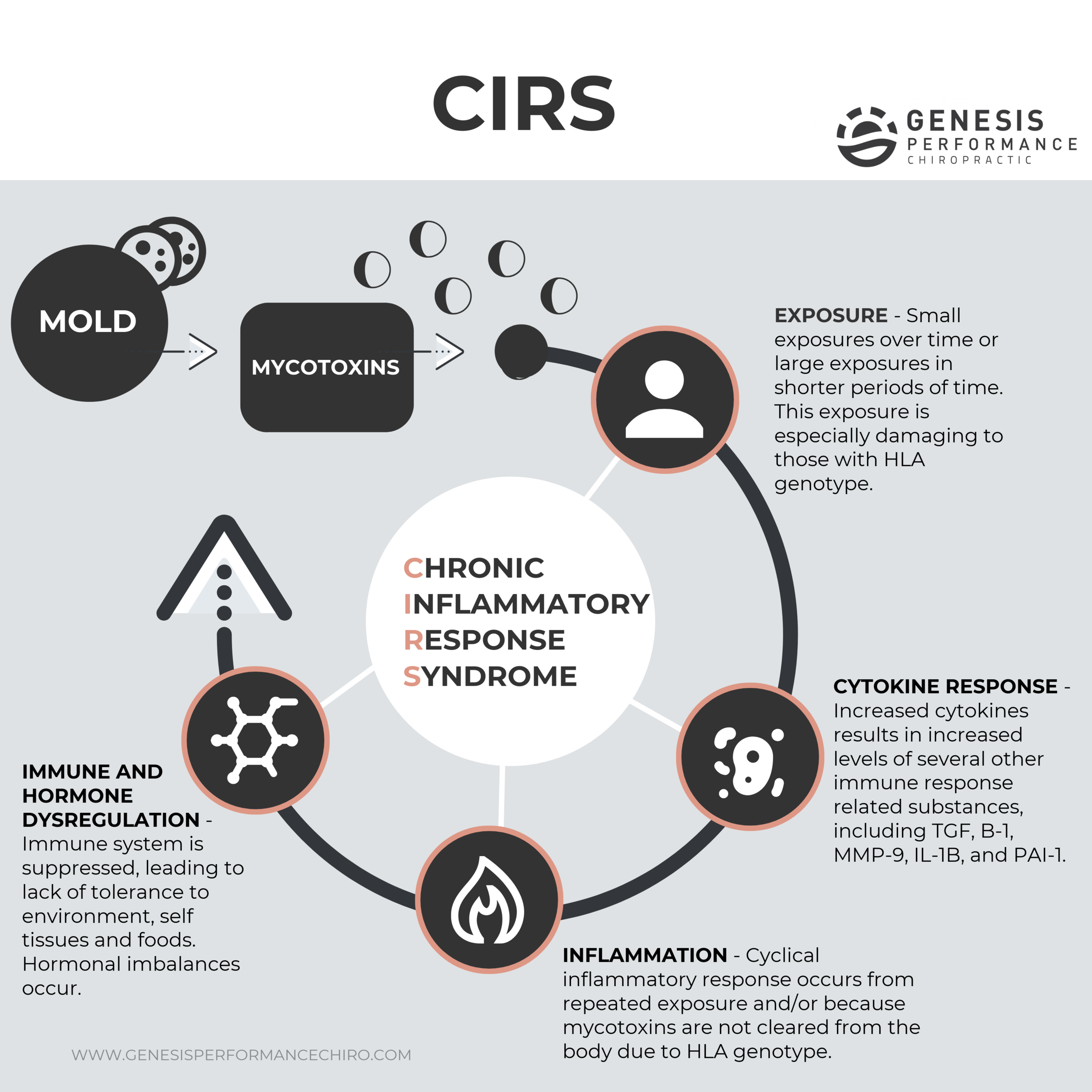How Mold and Mycotoxins Affect Your Body's Function
If you read our previous article, you may remember that mold illness is also called CIRS (Chronic Inflammatory Response Syndrome). CIRS is a condition that occurs when someone who is susceptible to mold has had significant mold exposure. A significant exposure could mean a large exposure for a short time or small exposures over a longer period of time. Those who are genetically susceptible to mold (those with HLA-DR genes) are most affected.
With this mold exposure, they are exposed to mycotoxins, which are the toxic chemicals present on mold spores and fragments of mold or fungus. Mycotoxins can easily travel through the air and be inhaled, and it’s also possible to digest them through consuming mold-contaminated food. Additionally, they can enter the body through skin contact with contaminated surfaces.
Dr. Ritchie Shoemaker, a research pioneer in the field of biotoxin related illness, discovered the process that the bodies of CIRS patients go through: The Biotoxin Pathway.
The Biotoxin Pathway
All cells have something called a surface receptor, which binds to other molecules and communicates to the cell what to do (Figure 1).
When a person has significant exposure to mycotoxins, the mycotoxins in the body will begin to bind to surface receptors of nearly every kind of cell in the body. This causes multiple inflammatory pathways to commence (Figure 2), including the production of pro-inflammatory cytokines, TGF Beta-1, MMP-9, IL-1B, and PAI-1.
While these inflammatory pathways of the immune system have an important role to play in addressing and healing insults to the body, ideally, they should be able to do their job and then calm down to restore homeostasis.
In the event of mold illness, the immune system flares up, but it never calms down. This can begin to cause tissue damage in the body.
Body Systems and Mycotoxins
This consistent inflammation from mycotoxins can lead to the following:
Cytokines bind with cell receptors, which can increase clot formation and arterial blockage and affect function of the hypothalamus. This can result in headaches, muscle aches, unstable temperature, and difficulty concentrating.
Increased cytokine levels also attract white blood cells which restrict blood flow and reduce oxygen in the tissues. Vascular endothelial growth factor (VEGF), which normally stimulates the formation of blood vessels, is reduced. Reduced VEGF can result in fatigue, shortness of breath, and muscle cramps.
People with HLA genotypes may develop other inappropriate immune responses, including the formation of antibodies that lead to a gluten sensitivity, ulcerative colitis, blood clotting conditions, and more. Inflammatory pathways are again continually activated, which increases inflammation in the body.
The body also then suffers from low MSH production. MSH (melanocyte-stimulating hormone) is a group of hormones made by the pituitary gland, hypothalamus, and skin cells. Low MSH can cause:
low melatonin (resulting in sleep problems)
reduced endorphin production (can lead to chronic, and sometimes unusual, pain)
malabsorption in the gut, which further weakens the immune system.
White blood cells can also lose the regulation of the cytokine response, which results in more infections and slower recovery from infections.
Reduced levels of MSH allow staph bacteria to persist in the biofilms of mucous membranes. This bacteria further decreases MSH levels, creating a vicious cycle of even lower MSH levels and the negative impact that low MSH levels have on the body (increased infections, poor sleep, chronic pain, gut malabsorption).
Low MSH can also decrease pituitary production of antidiuretic hormone (ADH). This leads to thirst, frequent urination, low blood pressure, low blood volume, and electric shocks from static electricity.
Mycotoxins don’t discriminate against any one part of the body. They can target all organ systems, including the nervous system, cardiovascular system, respiratory system, digestive system, urinary system, immune system, endocrine system, reproductive system, and the integumentary system (skin, hair, nails). (1)
Tolerance and CIRS
This inflammatory process can then become cyclical from repeated exposures to mold and/or because the mycotoxins are not cleared from the body in those who have the HLA genotype.
For these individuals, their immune system becomes dysregulated.
This immune dysregulation can create:
Lack of tolerance to environment - multiple chemical sensitivities Increasing reactions to foods - food sensitivities
Lack of self tolerance - leading to autoimmunity (destruction of self tissues)
Hormonal disturbances - blood sugar regulation issues, altered thyroid patterns and a whole host of hormonal imbalances
Specific Molds, Mycotoxins and Their Effects
As we learn about molds, it’s important to know the major mold categories and what to look out for. Though this is not an exhaustive list, we will describe some of the more prolific mold categories, what they look like, and where they’re found.
Fusarium
Fusarium is a large genus of fungi. While many of its species are harmless and act as decomposers, some are pathogens that can be serious threats to agriculture. If Fusarium species make their way indoors, they can grow quickly and cause structural damage, along with making you sick. Fusarium mold often appears black. Fusarium can also enter and grow on or in humans through inhalation, contact with contaminated surfaces, or consumption with contaminated food. Some of these molds cause superficial or local infections, which can be treated with an antifungal. Others can be disseminated infections, which means they travel from their place of origin (respiratory tract, gastrointestinal tract, skin) to other parts of the body. These infections are more serious and more likely in those with a compromised immune system. (2)
Aspergillus
Aspergillus molds can be found on dead leaves, compost piles, grains, and other foods. It is estimated that 25% of the world’s agriculture is contaminated with mycotoxins, often from aspergillus molds (3). These molds are often black on the surface and white-ish or yellow underneath. The most common mycotoxins found in food are aflotoxins, which are associated with aspergillus molds. Much of aspergillus exposure can be traced back to diet (corn, peanuts, and certain tree nuts are often affected), though there is mounting evidence that inhalation of aspergillus and its associated mycotoxins are also contributing to symptoms and disease. Its spores can be carried inside and grown indoors (4, 5).
For those with chronic lung problems or weak immune systems, aspergillosis is a concern with exposure to aspergillus.
There are three types of this condition: pulmonary aspergillosis, allergic bronchopulmonary aspergillosis, and invasive aspergillosis.
In pulmonary aspergillosis, no symptoms may appear in the early stages. As it progresses, symptoms may include: coughing (sometimes accompanied with mucus or blood), wheezing, fever, chest pain, difficulty breathing.
In allergic bronchopulmonary aspergillosis, people experience an allergic reaction after exposure to the apsergillus fungus. This causes inflammation in the lungs and air passages. This condition is more common in those with asthma, cystic fibrosis, or bronchiectasis. Symptoms may include: coughing (may be accompanied by mucus or blood), wheezing or worsening of asthma, fever, increased mucus, and/or inability to tolerate exercise due to asthma.
In the most severe type, invasive apsergillosis, the infection travels from the lungs to the bloodstream affecting organs, such as the kidneys, liver, skin or brain. People with weakened immune systems are more susceptible to this type. Symptoms include, fever, chills, difficulty breathing, kidney or liver failure, shock, cough with blood, or bleeding from lungs. If not treated, it may result in death. (6)
Penicillium
Penicillium can also be found in our air, our soil, and our homes. There are over 300 species of penicillium, and they are often recognized by their green, blue-green, or gray-green color. They can also be white, yellow, or pinkish. Penicillium was the mold that was responsible for the antibiotic, penicillin, which treats infections that are bacterial in nature.
When we inhale these penicillium mold spores, they can cause respiratory issues (coughing, shortness of breath, chronic sinusitis, sneezing, runny nose). People can also experience rashes, hives, or swelling of the throat. Mycotoxins from some species of penicillium can also lead to damage of the internal organs. (7)
Stachybotrys chartarum
Stachybotrys chartarum is known as black mold or toxic black mold. Sometimes it’s found in soil or grain, but it is most often found indoors in water-damaged buildings. It can easily grow on material with a high cellulose content, such as fiberboard, gypsum board, and paper. Constant moisture is required for its growth, which is a major reason to check for structural leaks and keep humidity at 50% or below. Though it’s hard to determine causation, a number of symptoms have been associated with high exposure of stachybotrys chartarum:
Nasal irritation, burning, and congestion
Cough
Wheezing
Chest tightness
Dyspnea
Headache
Irritability
Lightheadedness
Sleeping difficulty
Concentration problems
Mental fatigue
Alopecia
Rashes
Eye irritation (8)
Below, you can see the mycotoxins that are associated with fusarium, aspergillus, penicillium, and stachybotrys chartarum.
While the above descriptions mention some of the more well-known conditions associated with these mold categories, we know that the mycotoxins from these molds can set off the inflammatory cascade shown in the graphic above, especially for susceptible individuals (those with the HLA gene). These are the individuals who end up with mold illness after mold exposure. For a more complete list of mold illness symptoms, please refer to our previous article.
Please know that if you are suffering from mold illness or other conditions associated with mold, you are not alone. Contact our office—we can help you.
Works cited:




